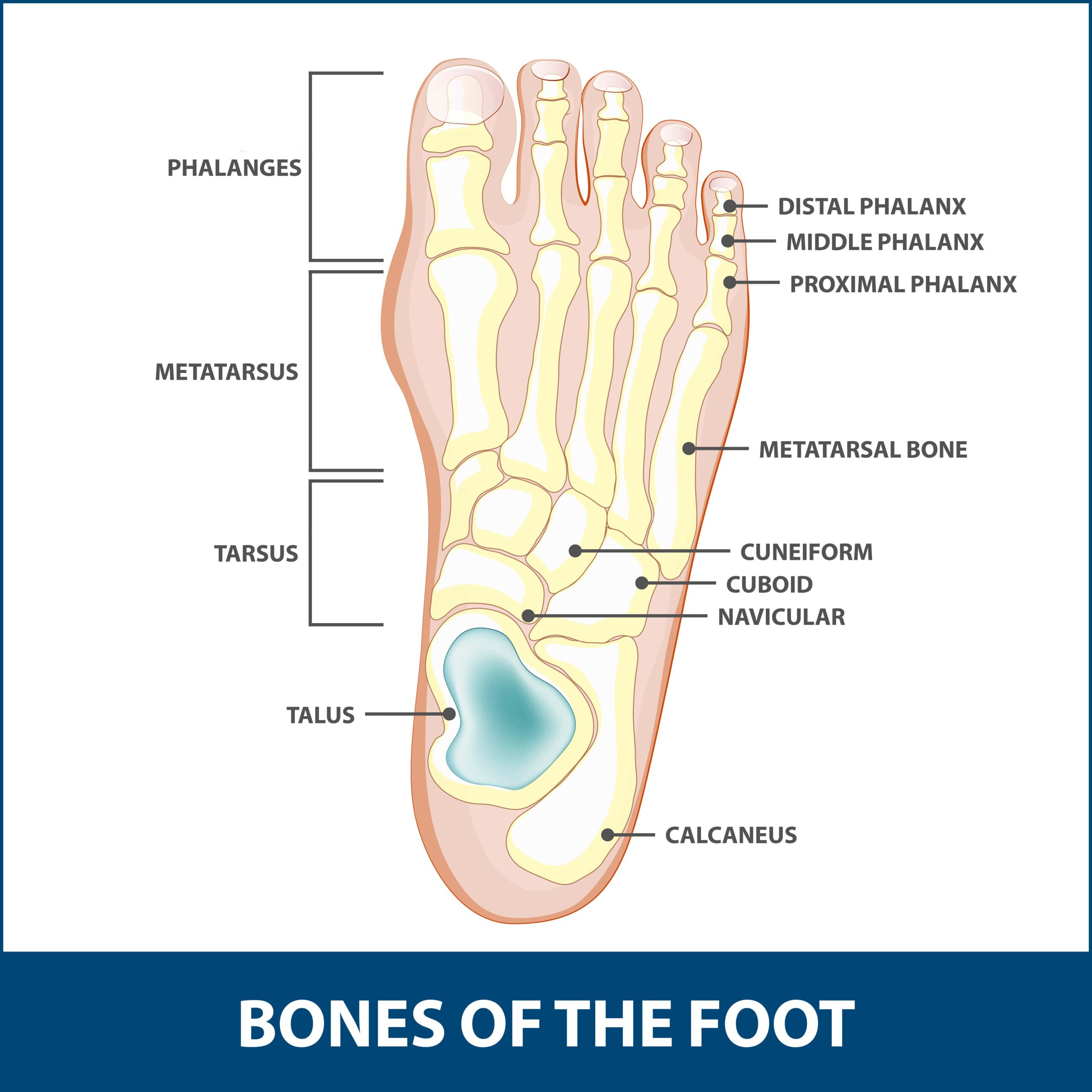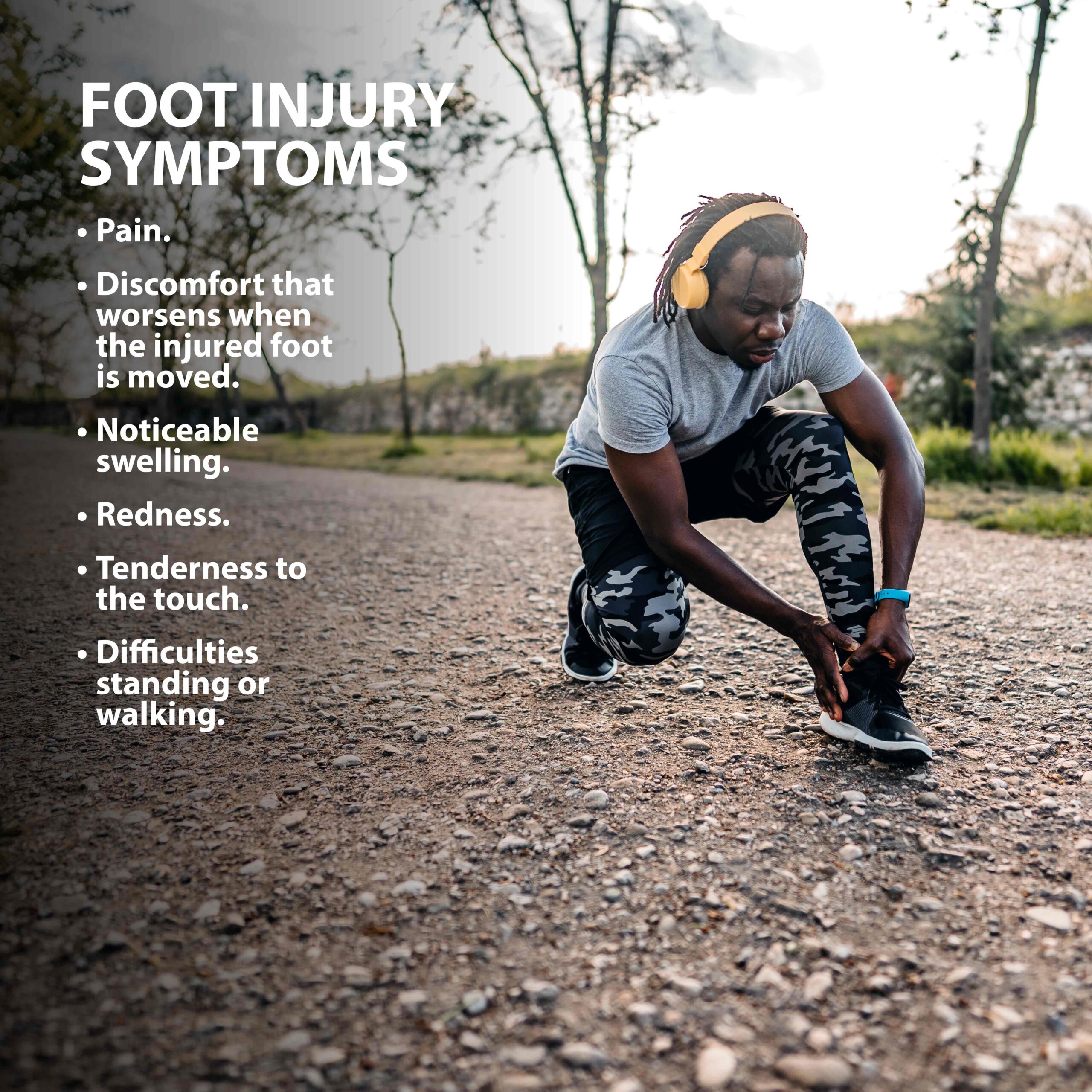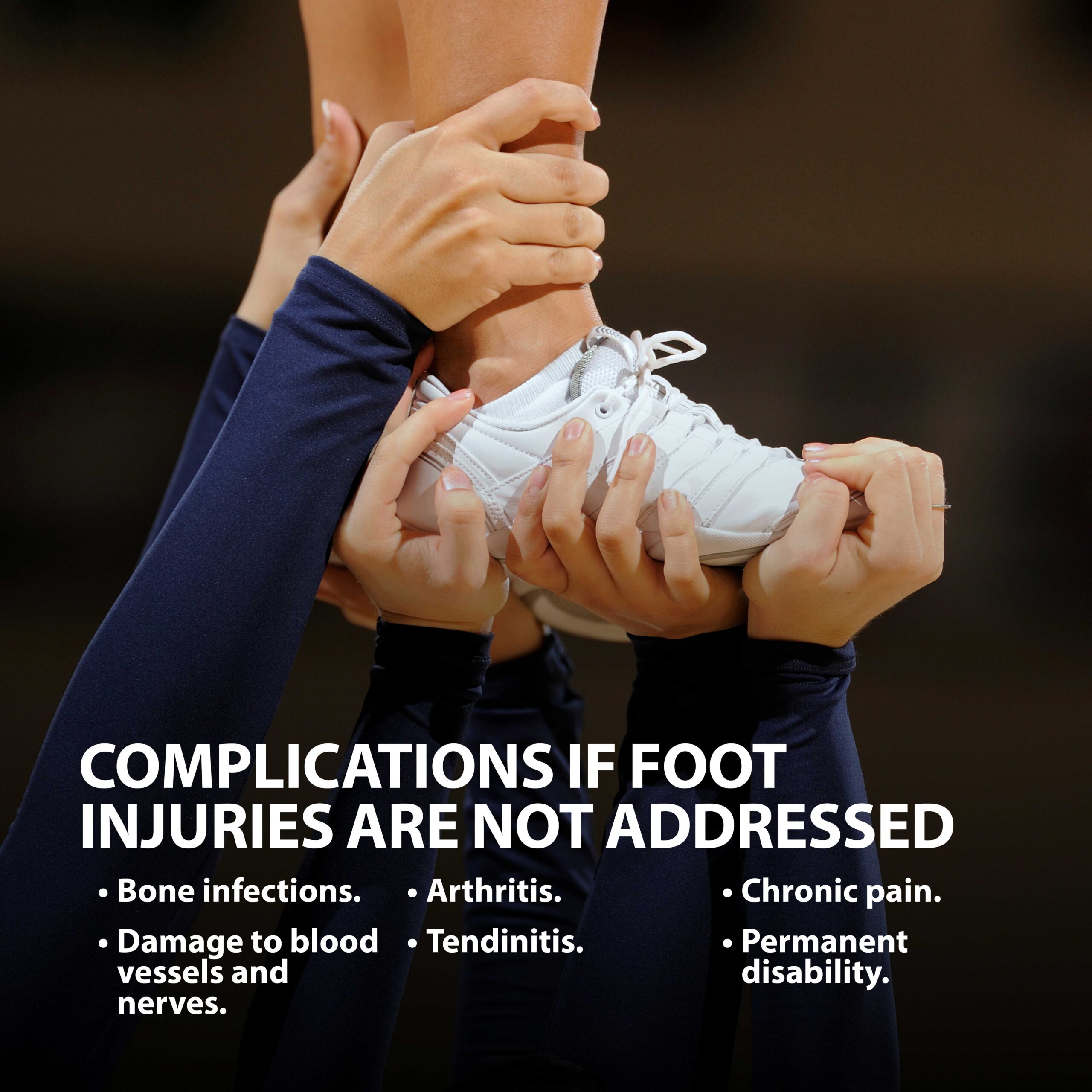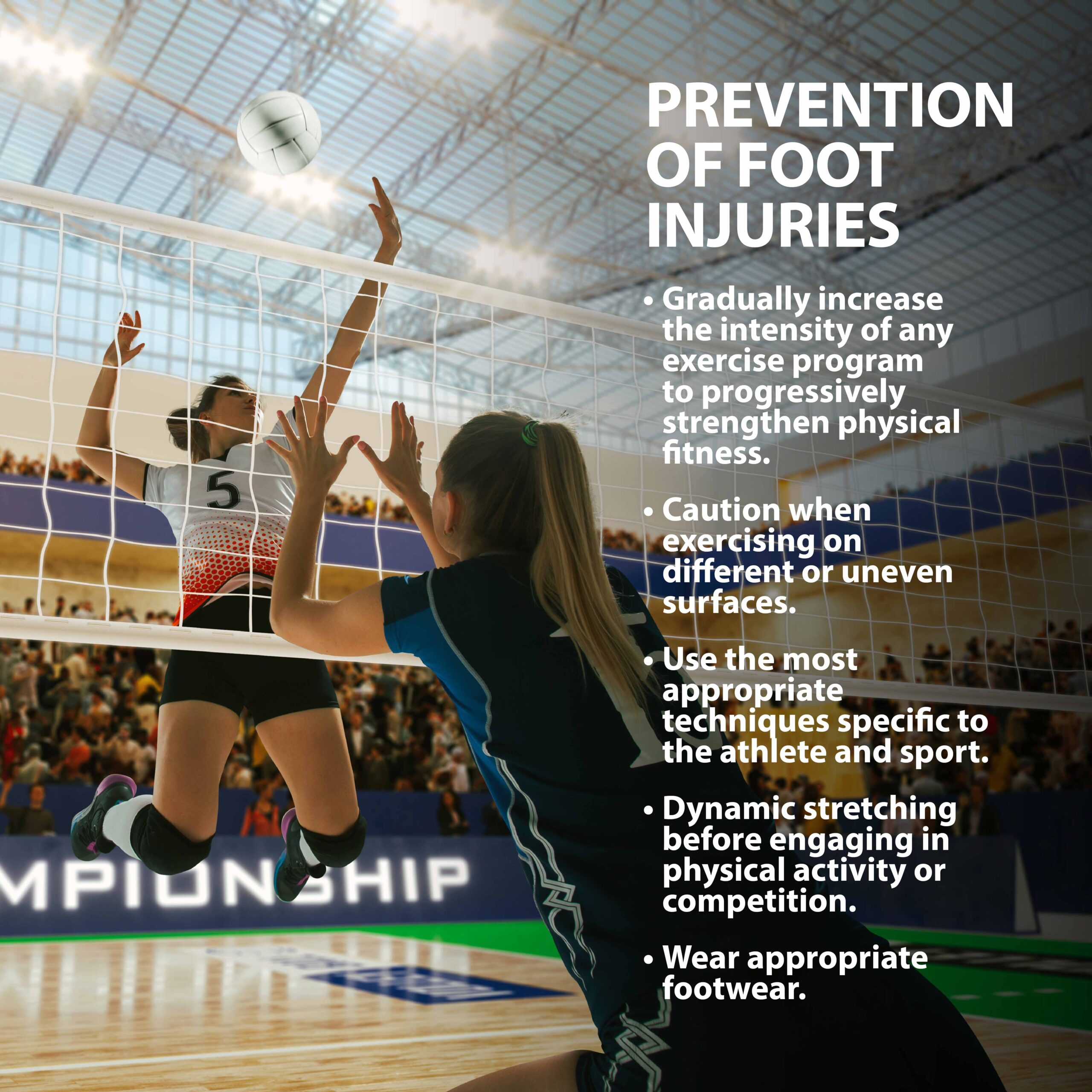Sports Injuries – Common Foot Fractures in Athletes
Overview
One might argue that athletes’ feet are their most utilized, important, but overlooked physical features. The simple fact is that athletes cannot stand, walk, run, or jump without well-functioning and healthy feet.
The workload that athletes’ feet are exposed to increases their risk for injury. Some of the most common sports injuries such individuals face include fractures of the feet.
Anatomy
Each foot contains 26 bones. These bones come in various shapes and sizes. The main areas in the feet that are most common for foot fractures are:
- Metatarsal: These long bones are located mid-foot, extending towards the toe bones.
- Calcaneus: The calcaneus (heel bone) is the largest of the tarsal bones in the foot. It lies at the back of the foot (hindfoot) below the three bones that make up the ankle joint
- Phalanges: The phalanges consist of the 14 bones that make up the toes.

Description
Overuse or sudden injury to the foot bones can result in cracks, medically known as fractures. While there are more common areas of the foot for fractures, these events can occur in any foot bone and range in severity, from simple and uncomplicated. Fractures can cause serious deformities and threaten other nearby physical features. Four of the most common foot fractures include:
- Metatarsal Fractures: The fifth metatarsal, the bone leading into the small toe, is the most frequently fractured metatarsal. The second most commonly broken metatarsal is the first one, which extends to the big toe. This is usually the most serious of such injuries and requires the most aggressive treatment. Fractures to the middle three metatarsals occur less frequently and often respond favorably to home-care treatments. Jones fractures occur in the fifth metatarsal bone, which is located on the outside of the foot.
- Heel Fractures: Heel fractures impact the heel bone (calcaneus). These events are usually significant and often limit one’s ability to stand or walk.
- Stress Fractures: Stress fractures are small cracks developing over an extended period. Usually, these injuries occur following repetitive stress on the affected bone from continual awkward or repetitive movements performed during athletic competition or at work.
- Toe Fractures: Toe fractures involve the bones directly inside each toe (phalanges). Many injuries occur when the toe is abnormally bent, twisted, or jammed into a hard or large object.
Causes
Foot fractures usually result from strange, forceful, or sudden motion impacting the foot. In other cases, overuse weakens bones, leaving them more likely to experience breaks.
Risk Factors
Athletes have a greater chance of sustaining foot fractures because they continually place excessive pressure on their feet and twist or bend them in unusual directions. Athletes at high risk are runners, tennis players, and those playing team sports such as basketball, cheerleading, gymnastics, volleyball, football, and soccer.
Symptoms
The symptoms depend on the specific bone involved, the location within the foot, and the severity of the initial impact. All foot fractures can produce common symptoms such as:
- Pain.
- Discomfort that worsens when the injured foot is moved.
- Noticeable swelling.
- Redness.
- Tenderness to the touch.
- Difficulties standing or walking.
In more serious instances, the affected foot might have clear deformities.

Complications
If foot fractures are not immediately addressed, you can risk developing serious, debilitating, and potentially life-threatening issues such as:
- Bone infections.
- Damage to blood vessels and nerves.
- Arthritis.
- Tendinitis.
- Chronic pain.
- Permanent disability.

Diagnosis
Doctors who suspect you may have some type of foot fracture often begin the diagnostic process by asking questions such as when the pain started, what kind of sports or leisure activities you take part in, and if any movements or actions worsen the discomfort.
Then they will likely do a complete visual examination to find any noticeable irregularities. Misshaped bones or other abnormalities can sometimes make diagnosis easier.
Often, foot fractures are officially confirmed using imaging devices like X-rays, MRI, or CT scans, which allow physicians to view a foot’s inner workings and easily identify fractures.
Treatment Overview
Mild to moderate fractures often heal with time and the use of non-invasive treatment methods:
Non-Surgical Options: Less severe breaks like stress fractures can improve over a relatively short time, provided the injured athlete limits the pressure placed upon their foot and performs home-care methods such as putting ice on the foot, restricting its movement using compressing devices like casts or ankle braces, and elevating it above their heart to reduce swelling.
Major fractures often need surgery. Common types of operations performed to correct foot fractures include:
- Reduction: During this process, surgeons place the two pieces of separated bone back together.
- Open Surgery: The most serious fractures usually need open surgery. This is a more complex process that involves the insertion of metal plates and screws into the damaged bone to keep it together long enough for the bone to heal fully and properly.
Recovery
Recovery depends on many factors. The most significant issues are the fracture’s severity and the treatment used to fix it. A less severe or clean break might heal faster than a bone broken in more than one place. An athlete’s biological and physical well-being and age also play into healing time frames.
Prevention
Fractures caused by sudden occurrences like car accidents and falls are difficult to prevent. Athletes can lessen their risk of foot fractures by engaging in preventative measures such as:
- Gradually increase the intensity of any exercise program to progressively strengthen physical fitness.
- Caution when exercising on different or uneven surfaces.
- Use the most appropriate techniques specific to the athlete and sport.
- Dynamic stretching before engaging in physical activity or competition.
- Wear appropriate footwear.
Athletes are urged to consume a healthy diet containing bone-strengthening nutrients like calcium and Vitamin D. Additionally, they should immediately stop any activity and seek medical care if they experience pain or other fracture-related symptoms.

Next Steps
Talk to your Florida Orthopaedic Institute physician to learn more about common foot fractures, what to prevent them, and what to do if they happen to you.
Areas of Focus
- Foot, Ankle & Lower Leg
- Achilles Tendinitis - Achilles Insertional Calcific Tendinopathy (ACIT)
- Achilles Tendon Rupture
- Achilles Tendonitis
- Ankle Fracture Surgery
- Ankle Fractures (Broken Ankle)
- Ankle Fusion Surgery
- Arthroscopic Articular Cartilage Repair
- Arthroscopy Of the Ankle
- Bunions
- Charcot Joint
- Common Foot Fractures in Athletes
- Foot Stress Fractures
- Hallux Rigidus Surgery - Cheilectomy
- Hammer Toe
- High Ankle Sprain (Syndesmosis Ligament Injury)
- Intraarticular Calcaneal Fracture
- Lisfranc Injuries
- Mallet, Hammer & Claw Toes
- Metatarsalgia
- Morton’s Neuroma
- Neuromas (Foot)
- Orthopedic Physician Or A Podiatrist? Definition of a Podiatrist
- Plantar Fasciitis
- Sports Foot Injuries
- Sprained Ankle
- Total Ankle Replacement
- Turf Toe
The following Florida Orthopaedic Institute physicians specialize in Common Foot Fractures in Athletes:
Specialties
- AC Joint Injuries
- Achilles Tendinitis - Achilles Insertional Calcific Tendinopathy (ACIT)
- Achilles Tendon Rupture
- Achilles Tendonitis
- ACL Injuries
- Ankle Fracture Surgery
- Ankle Fractures (Broken Ankle)
- Ankle Fusion Surgery
- Anterior Cervical Corpectomy & Discectomy
- Arthroscopic Articular Cartilage Repair
- Arthroscopic Chondroplasty
- Arthroscopic Debridement of the Elbow
- Arthroscopy Of the Ankle
- Articular Cartilage Restoration
- Artificial Disk Replacement (ADR)
- Aspiration of the Olecranon Bursa - Fluid In Elbow
- Atraumatic Shoulder Instability
- Avascular Necrosis (Osteonecrosis)
- Bankart Repair
- Basal Joint Surgery
- Bicep Tendon Tear
- Bicep Tenodesis
- Bone Cement Injection
- Bone Growth Stimulation
- Bone Health Clinic
- Broken Collarbone
- Bunions
- Bursitis of the Shoulder (Subacromial Bursitis)
- Calcific Tendinitis of the Shoulder
- Carpal Tunnel Syndrome
- Charcot Joint
- Chiropractic
- Clavicle Fractures
- Colles’ Fractures (Broken Wrist)
- Common Foot Fractures in Athletes
- Community Outreach
- Cubital Tunnel Syndrome
- De Quervain's Tenosynovitis
- Deep Thigh Bruising
- Degenerative Disk Disease
- Diffuse Idiopathic Skeletal Hyperostosis (DISH)
- Discectomy
- Discitis Treatment & Information
- Dislocated Shoulder
- Dupuytren’s Disease
- Elbow
- Elbow Bursitis
- Elbow Injuries & Inner Elbow Pain in Throwing Athletes
- Epidural Injections for Spinal Pain
- Finger Dislocation
- Flexor Tendonitis
- Foot Stress Fractures
- Foot, Ankle & Lower Leg
- Foraminotomy
- Fractured Fingers
- Fractures Of The Shoulder Blade (Scapula)
- Fractures Of The Tibial Spine
- Functional Nerve Transfers of The Hand
- Ganglion Cysts
- General Orthopedics
- Glenoid Labrum Tear
- Golfer's Elbow
- Groin Strains and Pulls
- Growth Plate Injuries Of The Elbow
- Hallux Rigidus Surgery - Cheilectomy
- Hammer Toe
- Hamstring Injuries
- Hand & Finger Replantation
- Hand & Wrist
- Hand Nerve Decompression
- Hand Skin Grafts
- Hand, Wrist, Elbow & Shoulder
- Heat Injury/Heat Prostration
- High Ankle Sprain (Syndesmosis Ligament Injury)
- Hip & Thigh
- Hip Arthroscopy
- Hip Dislocation
- Hip Flexor Strains
- Hip Fractures
- Hip Hemiarthroplasty
- Hip Impingement Labral Tears
- Hip Muscle Strains
- Hip Pointers and Trochanteric Bursitis
- Hyperextension Injury of the Elbow
- Iliopsoas Tenotomy
- Iliotibial Band Syndrome
- Impingement Syndrome of the Shoulder
- Interlaminar Implants
- Interlaminar Lumbar Instrumental Fusion: ILIF
- Interventional Pain Management
- Interventional Spine
- Intraarticular Calcaneal Fracture
- Joint Replacement
- Knee & Leg
- Kyphoplasty (Balloon Vertebroplasty)
- Kyphosis
- Labral Tears Of The Hip (Acetabular Labrum Tears)
- Laminectomy: Decompression Surgery
- Lateral Collateral Ligament (LCL) Injuries
- Lisfranc Injuries
- Little League Shoulder
- LITTLE LEAGUER'S ELBOW (MEDIAL APOPHYSITIS)
- Lumbar Epidural Steroid Injection
- Lumbar Interbody Fusion (IBF)
- MACI
- Mallet, Hammer & Claw Toes
- Medial Collateral Ligament Injuries
- Meniscus Tears
- Metatarsalgia
- Minimally Invasive Spine Surgery
- Morton’s Neuroma
- Muscle Spasms
- Muscle Strains of The Calf
- Nerve Pain
- Neuromas (Foot)
- Neurosurgery
- Olecranon Stress Fractures
- Orthopaedic Total Wellness
- Orthopaedic Trauma
- Orthopedic Physician Or A Podiatrist? Definition of a Podiatrist
- Osteoarthritis of the Hip
- Osteoporosis
- Outpatient Spine Surgery
- Partial Knee Replacement
- Patellar Fracture
- Pelvic Ring Fractures
- Peripheral Nerve Surgery (Hand) Revision
- Pinched Nerve
- Piriformis Syndrome
- Piriformis Syndrome
- Plantar Fasciitis
- Plastic Surgery
- Podiatry
- Primary Care Sports Medicine
- Quadriceps Tendon Tear
- Radial Tunnel Syndrome (Entrapment of the Radial Nerve)
- Revascularization of the Hand
- Reverse Total Shoulder Replacement
- Rheumatoid Arthritis (RA) of the Shoulder
- Rheumatoid Arthritis Of The Hand
- Robotics
- Rotator Cuff Tears
- Runner's Knee
- Sacroiliac Joint Pain
- Sciatica
- Scoliosis
- Senior Strong
- Shin Splints
- Shoulder
- Shoulder Arthritis
- Shoulder Arthroscopy
- Shoulder Injury: Pain In The Overhead Athlete
- Shoulder Replacement
- Shoulder Separations
- Shoulder Socket Fracture (Glenoid Fracture)
- SLAP Tears & Repairs
- Spinal Fusion
- Spine
- Spondylolisthesis and Spondylolysis
- Sports Foot Injuries
- Sports Hernias (Athletic Pubalgia)
- Sports Medicine
- Sports Wrist and Hand Injuries
- Sprained Ankle
- Sprained Wrist Symptoms and Treatment
- Subacromial Decompression
- Sudden (Acute) Finger, Hand & Wrist Injuries
- Targeted Muscle Reinnervation (TMR)
- Tendon Transfers of The Hand
- Tennis Elbow Treatment
- Thigh Fractures
- Thigh Muscle Strains
- Thumb Ulnar Collateral Ligament Injuries
- Total Ankle Replacement
- Total Hip Arthroplasty
- Total Hip Replacement - Anterior Approach
- Total Knee Replacement Surgery
- Trapezius Strain (Muscle Strain of The Upper Back)
- Traumatic Shoulder Instability
- Tricep Pain & Tendonitis
- Trigger Finger
- Turf Toe
- UCL (Ulnar Collateral Ligament) Injuries
- Ulnar Neuritis
- Valgus Extension Overload
- Vertebroplasty
- WALANT (Wide Awake Local Anesthesia No Tourniquet)
- Whiplash and Whiplash Associated Disorder (WAD)
- Wound Care
- Wrist Arthroscopy
- Wrist Fractures
- Wrist Tendonitis
Services
- Physical Medicine & Rehabilitation
- Physical Therapy
- Primary Care Sports Medicine
- PROMs (Patient-Reported Outcome Measures)
- Same-Day Orthopaedic Appointments Now Available
- Sports Medicine
- Sports-Related Concussion Treatment
- Telehealth Page
- Telemedicine
- Workers' Compensation
- Workers' Compensation Dispensary
- X-Ray
